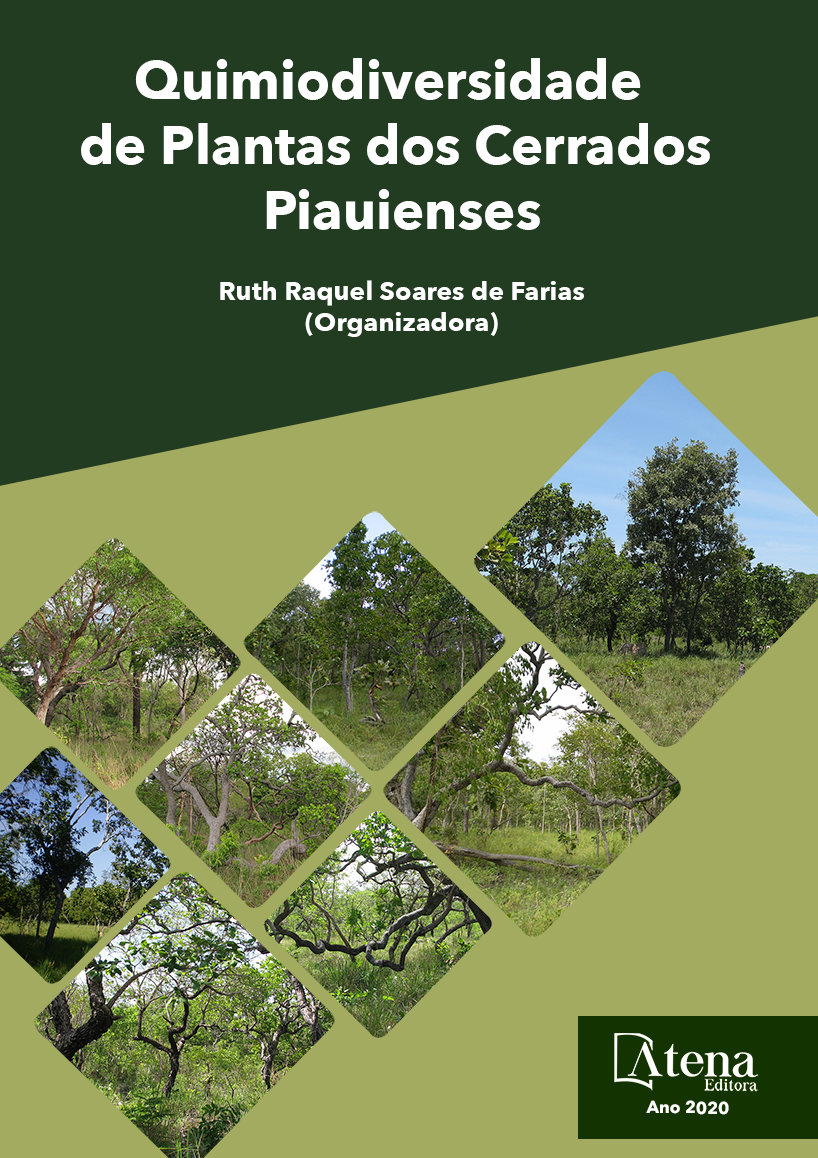
ANÁLISE COMPARATIVA DE EXTRATOS DAS FOLHAS DE Terminalia actinophylla MART. DE DUAS ÁREAS DE CERRADO: POTENCIAL FARMACOLÓGICO
O trabalho teve como objetivo
investigar o potencial farmacológico dos
extratos hexânico, etanólico e aquoso das
folhas da espécie Terminalia actinophylla Mart.
de duas regiões do Cerrado: Setentrional e
Meridional do estado do Piauí. O perfil químico
dos extratos foi obtido por cromatografia líquida
de alta eficiência. A atividade antioxidante foi
avaliada pelos ensaios dos radicais 2,2-difenil-
1-picrilhidrazila (DPPH), hidroxila e óxido nítrico,
substâncias reagentes ao ácido tiobarbitúrico e
redução do Fe3+ à Fe2+. O teor de fenóis totais
foi determinado pelo método de Folin–Ciocalteu
e de flavonoides totais por redução com cloreto
de alumínio. A atividade acetilcolinesterásica
foi avaliada por cromatografia em camada
delgada utilizando como revelador o reagente
de Ellman. A citotoxicidade dos extratos foi
investigada pelo método MTT em relação a
três linhagens de células tumorais humanas
(ovário, glioblastoma e cólon). A determinação
do fator de proteção solar (FPS) foi realizada
por método espectrofotométrico no intervalo
de 260 a 400 nm. Os extratos etanólicos e
aquosos de T. actinophylla apresentaram
atividade citotóxica em pelo menos uma das
linhagens testadas. A espécie se destaca por
apresentar atividade antioxidante e altos teores
de fenois e flavonóides totais. Todos os extratos
de T. actinophylla do Cerrado Meridional
demonstraram atividade anticolinesterásica.
Os testes biológicos realizados, o perfil cromatográfico e a análise dos componentes
principais demonstram que há uma diferença no potencial químico e biológico
dos espécimes. Além de disso, sugere que a planta tem um promissor uso como
antioxidante, anticolinesterásica e fotoprotetora.
ANÁLISE COMPARATIVA DE EXTRATOS DAS FOLHAS DE Terminalia actinophylla MART. DE DUAS ÁREAS DE CERRADO: POTENCIAL FARMACOLÓGICO
-
DOI: 10.22533/at.ed.3482005033
-
Palavras-chave: Antioxidante. Fotoproteção. Biodiversidade. Cerrados do Nordeste.
-
Keywords: Antioxidant. Photoprotection. Biodiversity. Cerrados of Northeast.
-
Abstract:
This study aimed to investigate the pharmacological potential of hexane,
ethanol and aqueous extracts from leaves of the species Terminalia actinophylla
Mart. of two Piauí state cerrado regions: Northern and Southern. The chemical profile
of the extracts was obtained by high-performance liquid chromatography (HPLC).
The antioxidant activity was evaluated by the test of the radicals 2,2-diphenyl-1-
picrylhydrazyl (DPPH), hydroxyl and nitric oxide, reactive substances to thiobarbituric
acid (TBARS), and reduction of Fe3+ to Fe2+. The determination of total phenolic and
flavonoid content was performed by the method of Folin-Ciocalteu and by reduction
with aluminum chloride, respectively. The anticholinesterase activity was assessed by
thin layer chromatography by using the Ellman reagent as revealer. The cytotoxicity
of the extracts was investigated by MTT method against three strains of human tumor
cells (ovarian, glioblastoma and colon). The determination of the sun protection factor
(SPF) was performed by spectrophotometric method in the range of 260 to 400 nm.
The ethanol and aqueous extracts of T. actinophylla exhibited cytotoxic activity in at
least one of the three strains tested. The species stands out for its antioxidant activity,
and its total phenolic and flavonoid content. All extracts of T. actinophylla from southern
cerrado demonstrated acetylcholinesterase activity. The biological tests performed, the
chromatographic profile and the analysis of the main components showed that there is
a difference in the chemical and biological potential of specimens. It is also suggested
that the plant has a promising use as antioxidant, anticholinesterasic, and sunscreen.
-
Número de páginas: 15
- Carlos Humberto Aires Matos Filho
- Márcia Denise Alves Veras
- Antonio Alberto Jorge Farias Castro
- Jéssica Pereira Costa
- Rusbene Bruno Fonseca de Carvalho
- George Laylson da Silva Oliveira
- Claudia do Ó Pessoa
- Chistiane Mendes Feitosa
- Paulo Michel Pinheiro Ferreira
- Mariana Helena Chaves
- Erika Thalyta Veras Pereira
- Ruth Raquel Soares de Farias
- Bruno


